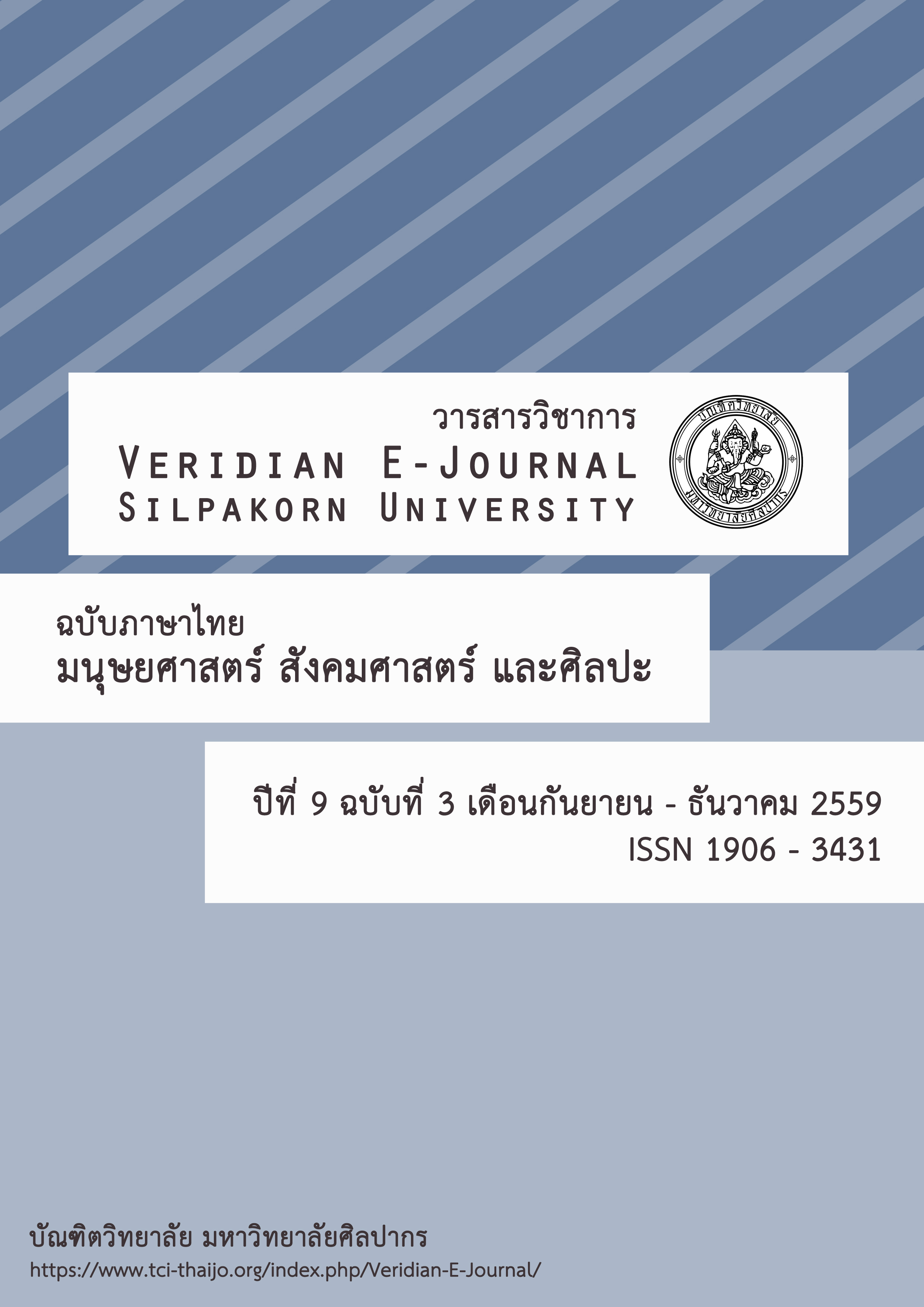การพัฒนารูปแบบกิจกรรมการเรียนรู้ของครู กศน.ตำบลในภูมิภาคตะวันตกเพื่อพัฒนา ทักษะการคิดของผู้เรียน
Main Article Content
Abstract
บทความนี้นำเสนอผลจากการพัฒนารูปแบบการจัดกิจกรรมการเรียนรู้ของครู กศน.ตำบลเพื่อพัฒนาทักษะการคิดของผู้เรียน ซึ่งกำหนดวัตถุประสงค์การวิจัยไว้ 3 ประการคือ 1) เพื่อศึกษาสภาพการจัดกิจกรรมการเรียนรู้ของครู กศน.ตำบล ในภูมิภาคตะวันตก 2) เพื่อสร้างและพัฒนารูปแบบการจัดกิจกรรมการเรียนรู้ของครู กศน.ตำบลในภูมิภาคตะวันตกเพื่อพัฒนาทักษะการคิดของผู้เรียน และ 3) เพื่อหาแนวทางพัฒนารูปแบบการจัดกิจกรรมการเรียนรู้ของครู กศน.ตำบลในภูมิภาคตะวันตกเพื่อพัฒนาทักษะการคิดของผู้เรียน ใช้ระเบียบวิธีวิจัยแบบการวิจัยและพัฒนา (R & D) มีพื้นที่ศึกษาในภูมิภาคตะวันตก 8 จังหวัด กลุ่มตัวอย่างและผู้ให้ข้อมูลหลักในการศึกษาคือ 1) ครู กศน. ตำบล 226 คน 2) ผู้บริหาร กศน. จำนวน 12 คน 3) ผู้บริหาร ครูกศน.ตำบล นักวิชาการ และผู้มีส่วนเกี่ยวข้องที่ร่วมสนทนากลุ่ม 22 คน เก็บรวบรวมข้อมูลในเดือนตุลาคม 2557-มิถุนายน 2558 วิเคราะห์ข้อมูลเชิงปริมาณโดยการหาค่าความถี่ ค่าร้อยละ ค่าเฉลี่ยเลขคณิต ส่วนเบี่ยงเบนมาตรฐาน ข้อมูลเชิงคุณภาพใช้การวิเคราะห์เนื้อหา ผลจากการศึกษาพบว่า
1. สภาพการจัดกิจกรรมการเรียนรู้ของครู กศน.ตำบลในภูมิภาคตะวันตก พบว่า ครูทำหน้าที่หลักในการจัดการเรียนการสอนทั้งระดับประถมศึกษา มัธยมศึกษาตอนต้น และมัธยมศึกษาตอนปลาย โดยใช้หลักสูตรแกนกลางที่กำหนดโดยส่วนกลาง ครูใช้การบูรณาการรายวิชาต่าง ๆ ผ่านกิจกรรมการเรียนการ
สอนที่ครูทำหน้าที่สอน ให้ความช่วยเหลือ แนะนำ สนับสนุน โดยเน้นให้ผู้เรียนได้ทำงานร่วมกัน และการประเมินผลใช้วิธีการประเมินจากการสอบและจากผลงานหรือชิ้นงาน ปัญหาในการจัดกิจกรรมการเรียนรู้คือ ครูสอนหลายรายวิชา สอนเด็กหลายกลุ่ม บางรายวิชาครูขาดประสบการณ์ในการสอน เนื่องจากครูมีวุฒิการศึกษาไม่ตรงกับรายวิชาที่สอน เนื้อหาที่กำหนดให้เรียนมีมากเกินไป ผู้เรียนบางคนไม่มีเวลามาเรียนเพราะต้องประกอบอาชีพ และข้อสอบบางรายวิชายากเกินไป
2. รูปแบบกิจกรรมการเรียนรู้ของครู กศน.ตำบลในภูมิภาคตะวันตกเพื่อพัฒนาทักษะการคิดของผู้เรียนที่สร้างและพัฒนาขึ้นคือ “รูปแบบพื้นที่ว่างแห่งการเรียนรู้” หรือ “SPACE OF Learning Model” มี 8 องค์ประกอบคือ 1)S: Sustainability คือ การคิดที่นำไปสู่ความยั่งยืน 2)P: Participation คือ การมีส่วนร่วมในกิจกรรมการเรียนรู้ 3) A: Aim คือ การมีเป้าหมายในการเรียนรู้ที่เหมาะสมกับตน 4) C:Creative Thinking คือ การคิดสร้างสรรค์ 5) E: Efficiency Economy คือ การประยุกต์ใช้ความรู้ตามแนวปรัชญาเศรษฐกิจพอเพียง 6)O: Opportunity คือ การให้โอกาสในการเรียนรู้ 7) F: Friendship คือ การมีสัมพันธภาพที่ดีในการเรียนรู้ และ 8) L: Learning คือ การเรียนรู้ที่สอดคล้องกับทักษะการเรียนรู้ในปัจจุบัน
3. แนวทางพัฒนารูปแบบการจัดกิจกรรมการเรียนรู้ของครู กศน.ตำบลในภูมิภาคตะวันตกเพื่อพัฒนาทักษะการคิดของผู้เรียน พบว่า ควรมีการพัฒนาทั้งในส่วนที่เกี่ยวข้องกับตัวครูผู้สอน หลักสูตร วิธีการวัดและประเมินผล เพื่อให้สอดคล้องกับสภาพความต้องการและความแตกต่างของผู้เรียน
This paper presented the findings on the development of learningactivities model of sub-district non-formal education facilitator in the Western Region to develop learners’ thinkingskills. The research objectives were to: 1) explore the situation of learning activity management of sub-district non-formal education facilitators in the western region, 2) create a model of learning activities to develop thinking skills for learners, and 3) find guidelines for the development of learning activities to promote thinking skills of learners of sub-district non-formal education facilitators in the western region. Research and development (R & D) was used in this study. The research area included eight provinces. The samples and key informants of the study were composed of 1) 226 sub-district non-formal education facilitators, 2) 12 administrators of district non-formal educational offices, 3) 22 key informants for focus group discussion: administers, teachers, academics, and stakeholders. The data were collected during October 2014 – June 2015. The collected quantitative data was analysed by frequency, percentage, arithmetic mean whereas content analysis was used to analyse qualitative data. The findings of the study were as follows:
1. The situation of the learning activity management of sub-district non-formal education in the western region was found that each facilitator was the principal manager of the instruction in all elementary, junior secondary, and senior secondary levels. Facilitator used the core curricula designed by the center focusing on the learners’ participation in teamwork and practice. Then the evaluation was conducted through the exams and work pieces. The problems of learning activity management were found that the facilitator taught several subjects to different learner groups. There was a lack of teaching experience of facilitators. The curriculum was composed of many subjects. Some learners could not attend their classes due to their jobs, and the exam items were too difficult for students.
2. The created model of learning activities to develop learners’ thinking skills for sub-district non-formal education facilitator in the western region was the “Space of Learning Model”. It was composed of eight elements: 1) S: Sustainability of thinking, 2) PซParticipation in learning, 3) A: Aim of oneself, 4) C: Creative thinking, 5) E: Efficiency economy application in daily life, 6) O: Opportunity providing to learners, 7) F: Friendship gained during happy learning, and 8) L: Learning activities consistent with learners’ current learning.
3. The guidelines for the development of learning activity model of sub-district non-formal education facilitators in the western region included the development of facilitators, curricula, and evaluation methods, to be in consistent with learners’ needs and differences.
